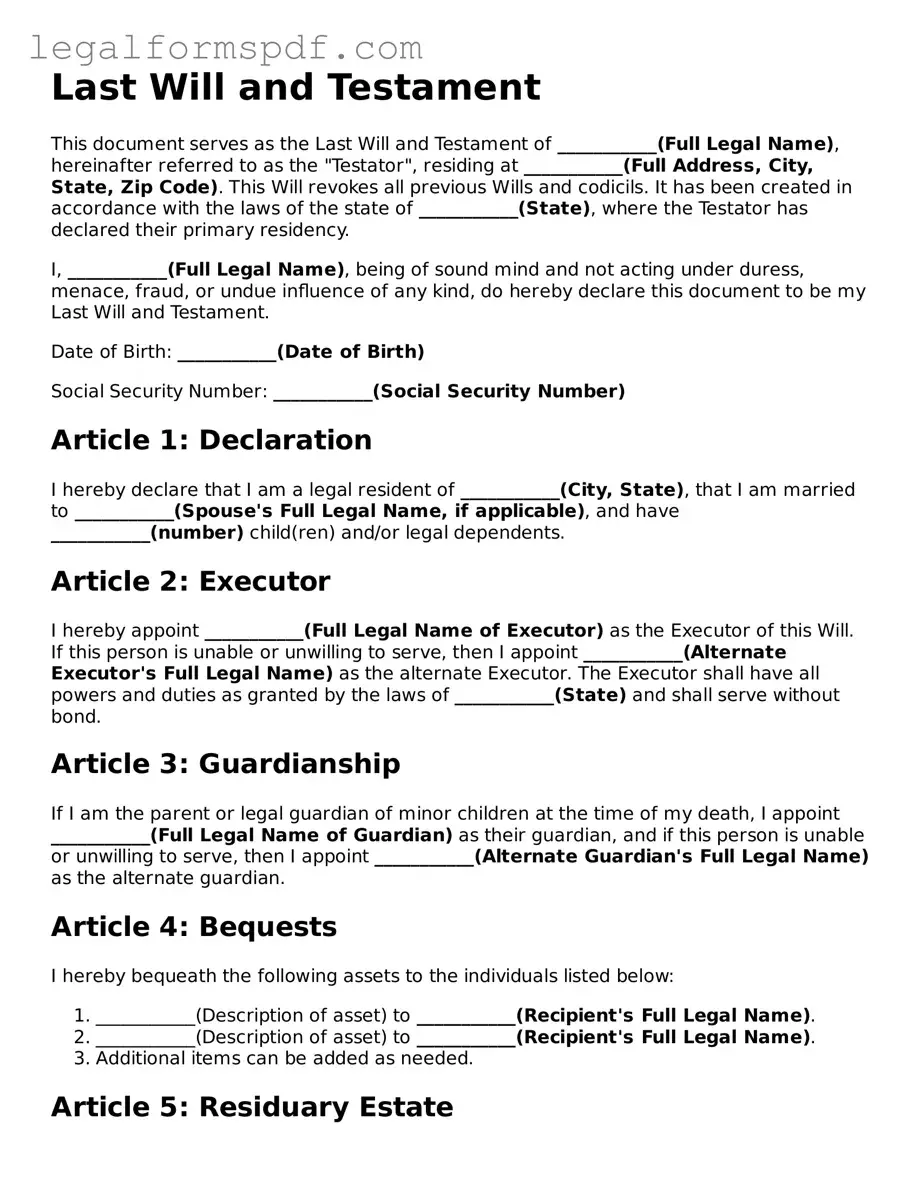Last Will and Testament
This document serves as the Last Will and Testament of ___________(Full Legal Name), hereinafter referred to as the "Testator", residing at ___________(Full Address, City, State, Zip Code). This Will revokes all previous Wills and codicils. It has been created in accordance with the laws of the state of ___________(State), where the Testator has declared their primary residency.
I, ___________(Full Legal Name), being of sound mind and not acting under duress, menace, fraud, or undue influence of any kind, do hereby declare this document to be my Last Will and Testament.
Date of Birth: ___________(Date of Birth)
Social Security Number: ___________(Social Security Number)
Article 1: Declaration
I hereby declare that I am a legal resident of ___________(City, State), that I am married to ___________(Spouse's Full Legal Name, if applicable), and have ___________(number) child(ren) and/or legal dependents.
Article 2: Executor
I hereby appoint ___________(Full Legal Name of Executor) as the Executor of this Will. If this person is unable or unwilling to serve, then I appoint ___________(Alternate Executor's Full Legal Name) as the alternate Executor. The Executor shall have all powers and duties as granted by the laws of ___________(State) and shall serve without bond.
Article 3: Guardianship
If I am the parent or legal guardian of minor children at the time of my death, I appoint ___________(Full Legal Name of Guardian) as their guardian, and if this person is unable or unwilling to serve, then I appoint ___________(Alternate Guardian's Full Legal Name) as the alternate guardian.
Article 4: Bequests
I hereby bequeath the following assets to the individuals listed below:
- ___________(Description of asset) to ___________(Recipient's Full Legal Name).
- ___________(Description of asset) to ___________(Recipient's Full Legal Name).
- Additional items can be added as needed.
Article 5: Residuary Estate
All the rest, residue, and remainder of my estate, not otherwise disposed of by this Will, shall be distributed to ___________(Recipient's Full Legal Name). If this recipient is deceased, the residuary estate shall pass to ___________(Alternate Recipient's Full Legal Name).
Article 6: Taxes and Expenses
All my lawful debts, funeral expenses, and expenses of last illness shall be paid from my estate before any distribution is made.
Article 7: Severability
If any part of this Will is ruled invalid, illegal, or unenforceable by a court, the remaining parts shall be unimpaired and remain in effect.
Signing
In witness whereof, I have hereunto set my hand and seal this ___________(Date).
_____________________(Signature of Testator)
Witnessed this day of ___________(Date) by:
- ___________(Witness 1 Full Legal Name), residing at ___________(Witness 1 Address)
- ___________(Witness 2 Full Legal Name), residing at ___________(Witness 2 Address)
Notary Public:
State of ___________(State)
County of ___________(County)
On ___________(Date), before me, ___________(Notary's Full Legal Name) personally appeared ___________(Full Legal Name of Testator), personally known to me (or proved to me on the oath of ___________(credible witness) or through __(type of identification)__) to be the person whose name is subscribed to the within instrument, and acknowledged to me that he/she executed the same in his/her authorized capacity, and that by his/her signature on the instrument, the person, or the entity upon behalf of which the person acted, executed the instrument.
Witness my hand and official seal:
_____________________(Signature of Notary Public)
Seal:
